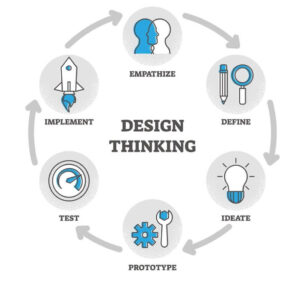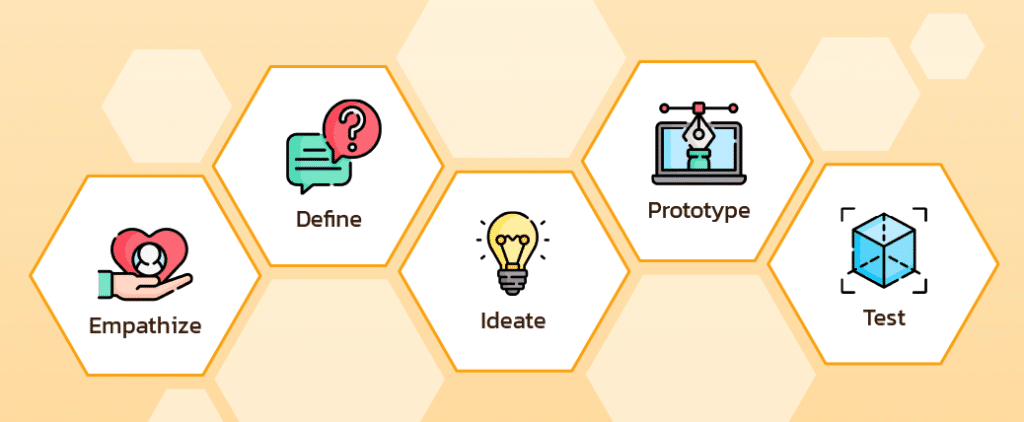
What is Design Thinking?
Design thinking is an iterative process in which we seek to understand our users, challenge assumptions, redefine problems and create innovative solutions which we can prototype and test. The overall goal is to identify alternative strategies and solutions that are not instantly apparent with our initial level of understanding.
Design thinking is an iterative and non-linear process that contains five phases :

Why Design Thinking is important?
Design thinking enables organizations to create lasting value for consumers. The process is helpful in any complex system (not just design systems) because it:
- Aims to solve a concrete human need.
Using an observational, human-centric approach, teams can uncover tricky point from the consumer that they hadn’t previously thought of, which the consumer may not even be aware of. Design thinking can provide solutions to those tricky points once they’re identified.
- Deals with problems that are ambiguous or difficult to define
Consumers often don’t understand clearly what problem they have that needs solving or can’t verbalize it. But upon careful observation, one can identify issues based on what they see from actual consumer behavior rather than simply working off of their ideas of the consumer. This helps define ambiguous problems and, in turn, makes it easier to surface solutions.
- Leads to more innovative solutions
Humans cannot imagine things that are not believed to be possible, making it impossible to ask for items that do not yet exist. Design thinking can help surface some of these unknown pain points that would otherwise have never been known. An iterative approach to tackle those problems often leads to non-obvious, innovative solutions.
- It makes organizations run faster and more efficiently.
Rather than researching a problem for a long time without devising an outcome, design thinking favors creating prototypes and testing to see how effective they are.
The Five Phases of Design Thinking
Phase 1: Empathize—Research, Consumer Understanding
Empathy provides the critical starting point for Design Thinking. The first phase of the process is spent getting to know the user and understanding their “desiderata”, needs, and objectives.
This means observing and engaging with people to understand them psychologically and emotionally. During this phase, the designer seeks to set aside their assumptions and gather real insights about the user.
Phase 2: Define—State Your Users’ Needs and Problems.
The second phase in Design Thinking is dedicated to defining the problem. You’ll gather your findings from the empathize phase and start to make sense of them: what difficulties and barriers are your users coming up against? What patterns do you observe? What is the big user problem that your team needs to solve?
By the end of the define phase, you will have a clear problem statement. The key here is to frame the problem in a user-centered way.
Phase 3: Ideate and Collaborate
With a deep understanding of your consumer and a focused, well-articulated challenge to solve, it’s time to start developing potential solutions. This phase is where creativity is unleashed on the intelligence where the rubber meets the road. Before the granularity of execution options, a multi-stakeholder team (led by design) must establish the creative or design “pathways” that might offer solutions. Before sketches or computer designs happen, we must align on where the challenge could take us and assess the creative legs and longevity of the opportunities we see in the landscape.
Brainstorming, mind-mapping, landscape mapping, and Post-it Notes are all viable tools to fuel this brilliant but messy phase. The key is to create an environment where divergent and provocative options are embraced and assessed, with the eventual goal of converging on a few strongest pathways to pursue. Leverage your intelligence and your defined brief as your yardstick, and do a S.W.O.T. (strengths, weaknesses, opportunities, threats) assessment to build confidence in the strategic viability of all pathways.
Phase 4: Prototype – Start to Create Solutions
This is an experimental phase. The aim is to identify the best possible solution for each problem. To investigate the ideas, your team should produce inexpensive scaled-down versions of the product (or specific features found within the product). This could involve paper prototyping.
Phase 5: Test—Try Your Solutions Out
Evaluators rigorously test the prototypes. Although this is the final phase, design thinking is iterative: Teams often use the results to redefine one or more further problems. So, you can return to previous stages to make different iterations, alterations, and refinements – to find or rule out alternative solutions.
What are the benefits of Design Thinking at work?
As a designer, you have a pivotal role in shaping the products and experiences your company puts to market. Integrating Design Thinking into your process can add huge business value, ultimately ensuring that the products you design are desirable for customers and viable in terms of company budget and resources.
With that in mind, let’s consider some of the main benefits of using Design Thinking at work:
- Significantly reduces time-to-market: With its emphasis on problem-solving and finding viable solutions, Design Thinking can significantly reduce the amount of time spent on design and development—especially in combination with lean and agile.
- Cost savings and a great ROI: Getting successful products to market faster saves the business money. Design Thinking has been proven to yield a significant return on investment; teams applying IBM’s Design Thinking practices, for example, have calculated an ROI of up to 300%.
- Improves customer retention and loyalty: Design Thinking ensures a user-centric approach, ultimately boosting user engagement and customer retention in the long term.
- Fosters innovation: Design Thinking is about challenging assumptions and established beliefs, encouraging all stakeholders to think outside the box. This enables a culture of innovation that extends well beyond the design team.
- Can be applied company-wide: The great thing about Design Thinking is that it’s not just for designers. It leverages group thinking and encourages cross-team collaboration. Moreover, it can be applied to virtually any team in any industry.
Whether you’re establishing a Design Thinking culture on a company-wide scale or simply trying to improve your approach to user-centric design, Design Thinking will help you to innovate, focus on the user, and ultimately design products that solve real user problems.
Convergence Consulting offers particularly qualified consultancy services within the Design Thinking process as well as in Product Design & Product Development. Contact us!



Leave a Reply